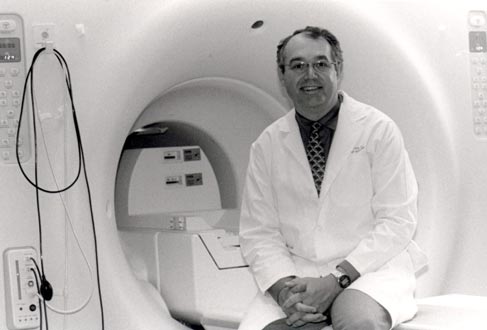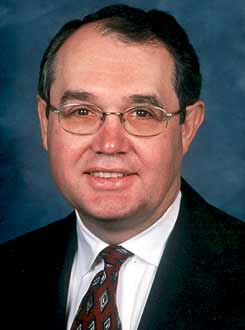(LITTLE ROCK, AR) - Women with breast cancer have new hope. Steven E. Harms, M.D., professor of radiology and director of imaging research at the University of Arkansas for Medical Sciences (UAMS) and chief of radiology at Central Arkansas Veterans Healthcare System, has developed a non-surgical treatment that destroys small breast tumors while causing no disfigurement of the breast. The laser lumpectomy procedure is made possible by Harms' development of RODEO (ROtating Delivery of Excitation Off-resonance) MRI (magnetic resonance imaging), which allows highly accurate detection of breast cancer.
"Almost no cosmetic side effects result from the laser lumpectomy procedure," Harms said. RODEO MRI is used as a guide for locating the tumor. RODEO MRI allows the physician to see the tumor as the patient is treated. An 18-gauge needle is placed into the tumor, and a fiber optic wire is advanced through the needle to heat the tumor cells until they are destroyed. The heating lasts only about 10 minutes.
"On RODEO MRI, tumors look like bright stars in a dark sky," Harms said. "The laser heat spreads in a sphere, and the image turns dark when the tumor is destroyed."
Harms presented the results of the first clinical trial to test the laser lumpectomy at the 84th annual meeting of the Radiological Society of North America (RSNA). That groundbreaking trial involved 30 patients with malignant breast cancers, who were treated with laser lumpectomy prior to surgical incision. The object of this trial, funded by the Department of Defense (DOD), was to see how well the cancerous tissue was destroyed. DOD funded another trial to take up where this one left off.
A second groundbreaking trial tested the procedure as a primary treatment on benign breast tumors. These benign tumors often cause lumps and pain. They usually occur in younger women, most of whom want to have them removed.
In the second trial, each laser lumpectomy was followed with ultrasound and MRI to confirm the disappearance of the lesion. The body absorbed the dead cells within six weeks to five months. Another trial funded by the Susan G. Komen Foundation is testing laser lumpectomy as a primary treatment on a highly selected group of breast cancer patients. These patients have malignant tumors (infiltrating ductal carcinoma) of no more than one centimeter. In addition to the laser lumpectomy, the patients receive another advance in breast cancer treatment. UAMS breast cancer surgeon, V. Suzanne Klimberg, M.D., performs a sentinel lymph node biopsy in which she removes the first draining lymph node and tests it. If it is cancer-free, no other nodes are removed. The patients are treated with radiation also. They receive five years of follow-up care, with rigorous clinical imaging, such as RODEO MRIs.
The National Cancer Institute (NCI) is funding another study to determine the accuracy of breast MRI. Patients selected for this trial must have highly suspicious lesions detected by mammograms or clinical exams.
NCI is funding another RODEO MRI study involving patients with at least a 30-percent lifetime risk of breast cancer. Participants must meet the risk requirement, which is determined through family history or genetic testing. These patients will receive bilateral MRIs each year for two years. Five other sites around the country are taking part in this pilot study. "We hope to collect data from this trial and then go on to a larger trial," Harms said.
The promise of these clinical trials is extremely optimistic. "We're going to have a whole new paradigm for breast cancer," Harms said. "In the past, we were significantly limited by what we did not know. We based treatment on projections of what a population of people would do instead of what an individual actually had. For example, many people got radiation and didn't really benefit from it. Statistics show that 70 percent of the people who get radiation with breast conservation treatment don't benefit.
"We are moving toward treatment that is sufficient for each patient's needs but avoids over-treatment that is unlikely to produce any benefit."
Harms emphasized that early detection is still the key to defeating breast cancer. "The problem with mammography is that although it detects some people's cancer early, it misses a lot of disease. We have the potential for much greater sensitivity with MRI to the point that we can actually exclude cancer."
Harms is working on an MRI machine designed specifically for breast imaging. At present, RODEO MRIs cost about $1300 per side. Some insurance companies will cover this expense, but some won't.
"For RODEO, we strip away a lot of the equipment of the regular MRI machine," Harms said. He is making some headway at getting this stripped-down version manufactured. RODEO MRI is available at UAMS and only seven other sites, which have obtained the technology from Harms. Two sites are located at Denver, two at Dallas, one at Baltimore, one at New York and one at Baptist Medical Center in Little Rock. "We have the most experience at UAMS since we have done about 3,000 RODEO studies," Harms said.
"The value of having a RODEO MRI - even if it comes out negative - is immeasurable. Knowing you don't have breast cancer takes a huge weight off your shoulders.
"Breast cancer is a common cancer. It's one that no one really brings on themselves, as is the case with cancers related to smoking," Harms said. "It often strikes women during the most productive times of their lives when people need them the most. It strikes out of nowhere.
"We have made progress," Harms concluded, "but we're not where we would like to be. We would like for people to think of breast cancer treatment as being only as difficult as removing a wart."
# # #
BACKGROUND
Recognized worldwide since 1990 for developing MRI (Magnetic Resonance Imaging) breast screening applications, Harms and his research group produced the first high-resolution breast MRI images by developing a software called ROtating Delivery of Excitation Off-resonance (RODEO).
Since the early 1990s, they have been honored for their work by nationally known foundations, said Harms. "We have been given awards from the Komen Foundation, the American Medical Association, and the Radiological Society of North America with the Shannon Award. When we introduced RODEO Breast MRI, it caught the radiology world by surprise. We also were recognized globally in major newspapers and featured in most of the women's magazines."
Because this software offers tremendous breakthroughs in breast imaging, the Department of Health and Human Services funded multi-site clinical trials. From that work, new recommendations for current standards in the breast cancer screening and treatment were established by an international consortium, composed of five working groups with Harms serving as chief investigator. The Office on Women's Health published their conclusions.
LUMPECTOMY
Rodeo MRI is proving to be especially helpful in the breast surgery called a lumpectomy, where only part of the breast is removed. With RODEO software, the surgeons can identify on the MRI where the tumor is located, and avoid repeat surgeries.
Harms said, "The ideal treatment for breast cancer, in terms of surgery, would be a lumpectomy. This preserves much of the breast tissue and reduces the deformity associated with breast cancer. Unfortunately, about half of the lumpectomies that are performed, have positive margins; in other words, the surgeon cuts across a part of the tumor and leaves some tumor behind in about half of the cases. This requires repeat surgery, either another lumpectomy or a mastectomy, and the other side of that, sometimes when you have no positives margins, more breast tissue is removed than actually is needed to cure the cancer. In that case, the deformity is worse than is needed.
"So, what we want to do is provide the information needed to do the ideal lumpectomy, in other words, one that removes all the cancer and preserves as much of the normal breast tissue as possible. RODEO allows us to very accurately to identify the margins of that cancer."
INCONCLUSIVE MAMMOGRAMS AND FALSE POSITIVES
Patients, who have a false positive from a standard breast exam, are finding that the MRI, using the RODEO technique, is a helpful alternative to the inconclusive mammogram, explained Harms. "The RODEO technique is an alternative to the inconclusive mammogram. In other words, patients who may not be well examined with mammography would include women with increased breast density, which occurs more commonly in pre-menopausal patients.
"Most women and their physicians are aware of the controversial regarding mammography and whether to get it at age 40 or whether to go on to age 50. This controversial comes from the fact that mammography doesn't work as well in pre-menopausal women because of the active ductal tissue. As hormonal supplements after menopause become more common, we are also seeing more breast density in the post-menopausal patients. So RODEO breast MRI may also be indicated in women on the age of 50 with active or prominent ductual tissue."
SILICONE IMPLANTS
Harms also noted how the breast MRI, using the RODEO software technique helps women with silicone implants. As a group, these patients also can have inconclusive mammograms. RODEO can distinguish between any leaks from the implants and possible tumors, Harms said, "People with silicone implants also have inconclusive mammograms. Silicone blocks X-rays and impairs mammography for making a diagnostic picture in many cases. Rodeo breast MRI can not only see through the silicone, but it also chemically can separate silicone from lesions in the breast. We often use Rodeo breast MRI to evaluate the integrity of the implant and to characterize lumps in the breast as either silicone leaks or possibly tumors because silicone has a characteristic signal that we can exploit RODEO MRI to make a chemically specific image for silicone. We can separate this from enhancing tumors in the breast quite readily. So, indeed we can tell a leak from a lump." |
|



